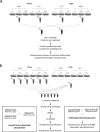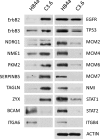Effects of ErbB2 Overexpression on the Proteome and ErbB Ligand-specific Phosphosignaling in Mammary Luminal Epithelial Cells
- PMID: 28174229
- PMCID: PMC5383782
- DOI: 10.1074/mcp.M116.061267
Effects of ErbB2 Overexpression on the Proteome and ErbB Ligand-specific Phosphosignaling in Mammary Luminal Epithelial Cells
Abstract
Most breast cancers arise from luminal epithelial cells, and 25-30% of these tumors overexpress the ErbB2/HER2 receptor that correlates with disease progression and poor prognosis. The mechanisms of ErbB2 signaling and the effects of its overexpression are not fully understood. Herein, stable isotope labeling by amino acids in cell culture (SILAC), expression profiling, and phosphopeptide enrichment of a relevant, non-transformed, and immortalized human mammary luminal epithelial cell model were used to profile ErbB2-dependent differences in protein expression and phosphorylation events triggered via EGF receptor (EGF treatment) and ErbB3 (HRG1β treatment) in the context of ErbB2 overexpression. Bioinformatics analysis was used to infer changes in cellular processes and signaling events. We demonstrate the complexity of the responses to oncogene expression and growth factor signaling, and we identify protein changes relevant to ErbB2-dependent altered cellular phenotype, in particular cell cycle progression and hyper-proliferation, reduced adhesion, and enhanced motility. Moreover, we define a novel mechanism by which ErbB signaling suppresses basal interferon signaling that would promote the survival and proliferation of mammary luminal epithelial cells. Numerous novel sites of growth factor-regulated phosphorylation were identified that were enhanced by ErbB2 overexpression, and we putatively link these to altered cell behavior and also highlight the importance of performing parallel protein expression profiling alongside phosphoproteomic analysis.
© 2017 by The American Society for Biochemistry and Molecular Biology, Inc.
Figures





Similar articles
-
Transcriptional profiling of ErbB signalling in mammary luminal epithelial cells--interplay of ErbB and IGF1 signalling through IGFBP3 regulation.BMC Cancer. 2010 Sep 14;10:490. doi: 10.1186/1471-2407-10-490. BMC Cancer. 2010. PMID: 20840765 Free PMC article.
-
Epidermal growth factor receptor, c-erbB2 and c-erbB3 receptor interaction, and related cell cycle kinetics of SK-BR-3 and BT474 breast carcinoma cells.Cytometry. 2001 Aug 1;44(4):338-48. doi: 10.1002/1097-0320(20010801)44:4<338::aid-cyto1125>3.0.co;2-v. Cytometry. 2001. PMID: 11500850
-
Expression profiling during mammary epithelial cell three-dimensional morphogenesis identifies PTPRO as a novel regulator of morphogenesis and ErbB2-mediated transformation.Mol Cell Biol. 2012 Oct;32(19):3913-24. doi: 10.1128/MCB.00068-12. Epub 2012 Jul 30. Mol Cell Biol. 2012. PMID: 22851698 Free PMC article.
-
The neuregulin-I/ErbB signaling system in development and disease.Adv Anat Embryol Cell Biol. 2007;190:1-65. Adv Anat Embryol Cell Biol. 2007. PMID: 17432114 Review.
-
ErbB2 activation and signal transduction in normal and malignant mammary cells.J Mammary Gland Biol Neoplasia. 1996 Apr;1(2):199-206. doi: 10.1007/BF02013643. J Mammary Gland Biol Neoplasia. 1996. PMID: 10887493 Review.
Cited by
-
Quantitative Phosphoproteomics Reveals a Role for Collapsin Response Mediator Protein 2 in PDGF-Induced Cell Migration.Sci Rep. 2017 Jun 21;7(1):3970. doi: 10.1038/s41598-017-04015-x. Sci Rep. 2017. PMID: 28638064 Free PMC article.
-
ErbB-2 signaling in advanced prostate cancer progression and potential therapy.Endocr Relat Cancer. 2019 Apr 1;26(4):R195-R209. doi: 10.1530/ERC-19-0009. Endocr Relat Cancer. 2019. PMID: 31294537 Free PMC article. Review.
-
Deciphering Cancer Complexity: Integrative Proteogenomics and Proteomics Approaches for Biomarker Discovery.Methods Mol Biol. 2025;2859:211-237. doi: 10.1007/978-1-0716-4152-1_12. Methods Mol Biol. 2025. PMID: 39436604 Review.
References
-
- Slamon D. J., Clark G. M., Wong S. G., Levin W. J., Ullrich A., and McGuire W. L. (1987) Human breast cancer: correlation of relapse and survival with amplification of the HER-2/neu oncogene. Science 235, 177–182 - PubMed
-
- Ross J. S., and Fletcher J. A. (1999) The HER-2/neu oncogene: prognostic factor, predictive factor and target for therapy. Semin. Cancer Biol. 9, 125–138 - PubMed
-
- Citri A., and Yarden Y. (2006) EGF-ERBB signalling: towards the systems level. Nat. Rev. Mol. Cell Biol. 7, 505–516 - PubMed
-
- Alroy I., and Yarden Y. (1997) The ErbB signaling network in embryogenesis and oncogenesis: signal diversification through combinatorial ligand-receptor interactions. FEBS Lett. 410, 83–86 - PubMed
Publication types
MeSH terms
Substances
Grants and funding
LinkOut - more resources
Full Text Sources
Other Literature Sources
Molecular Biology Databases
Research Materials
Miscellaneous

